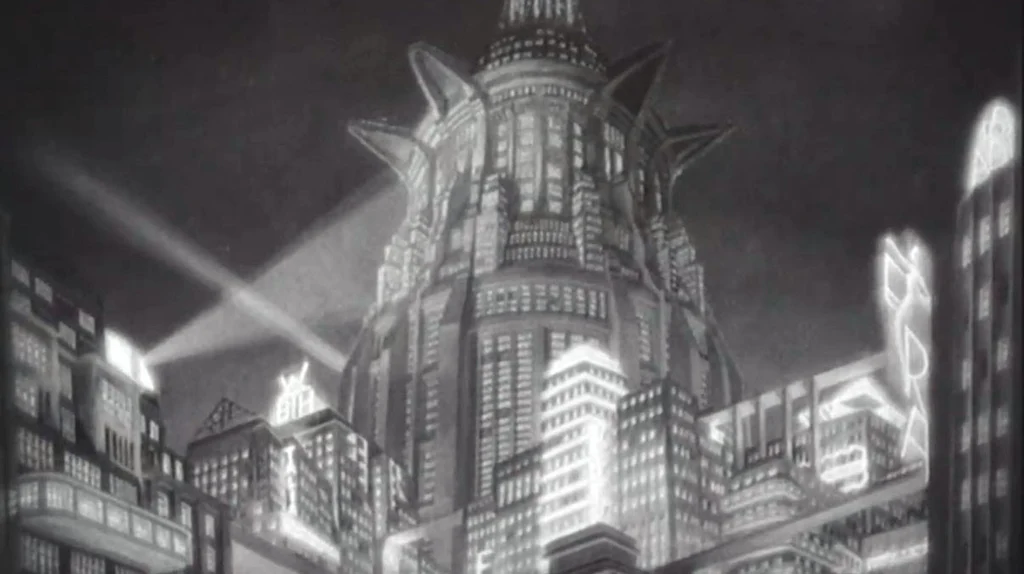Film, Neon und ihre gegenseitige Anerkennung
Die alljährlichen Filmfestspiele auf der Berlinale sind ein Höhepunkt im Kalender Berlins und als Symbol der Stadt vergeben wir keine goldenen Oscars oder Globes, sondern Bären. Das mitreißende Programm des Festivals umfasst die Vorführung von Hunderten von Filmen in Kinos in der ganzen Stadt sowie eine fortlaufende Liste von Veranstaltungen, die sich mit den Themen Essen, Genuss und Umwelt befassen.
2016 waren wir stolz darauf, die magische Welt des Films mit Neon zu feiern, indem wir ein Neonschild mit dem Berlinale-Logo produzierten, ganz im Sinne der traditionellen bunten und schimmernden Kinotafeln des 20. Jahrhunderts.
Um auf das wichtigste Filmfestival Berlins anzustoßen, haben wir den Spieß umgedreht und ein paar Beispiele gesammelt, in denen das Kino Neon gefeiert hat.
Metropolis (1927)
Es ist wirklich schade, dass der Film 1927 noch schwarz-weiß war, denn eine der ersten Produktionen, die einem einfällt, wenn man an Neon im Film denkt, ist Fritz Langs Metropolis. Gerade die 20er Jahre waren die Jahre, in denen Neon boomte und sich in den großen Metropolen Amerikas ausbreitete, und zufällig wissen wir, dass New York 1927 mit 650 Neonschildern prahlte.
Lang verwendete Neon nicht nur, um eine futuristische Stadtvision zu schaffen, sondern auch in der epischen und revolutionären Szene der Verwandlung des Roboters in das Ebenbild der Hauptfigur, Maria. Das Bühnenbild, für das eine ganze Stadt in Miniatur nachgebaut werden musste, gehörte zu den anspruchsvollsten, die je für die damalige Zeit produziert wurden, und die Produktion muss einfach überwältigend gewesen sein.

Obwohl er bei seiner Veröffentlichung keinen finanziellen Erfolg hatte, wurde Metropolis zu einer Ikone des Science-Fiction-Kinos. Anlässlich des 90. Jahrestages seiner Veröffentlichung wurde der Film restauriert und in einer erweiterten Fassung neu aufgelegt. Das Kino Babylon veranstaltete im Januar 2017 eine Galavorstellung mit einem Live-Orchester, das den Stummfilm begleitete – man stelle sich nur die Eröffnungsszene vor!

Tron (1982)
Einer der Filme, der wohl am stärksten von Metropolis beeinflusst wurde, war Tron: der weltweit erste Zeichentrickfilm mit Schwarzlicht, der 1982 von Walt Disney veröffentlicht wurde. Zu diesem Zeitpunkt hatte Neon bereits eine klare Assoziation mit futuristischer, technologischer Ästhetik: In den 70er Jahren war es von George Lucas in Form der legendären Lichtschwerter von Star Wars in eine Waffe verwandelt worden. Einige Jahre später hatten der Regisseur Stevel Lisberger und sein Team die Idee eines Kriegers aus Neon, aber außer seinem phosphoreszierenden Aussehen und einem Namen – Tron – hatte er weder eine Geschichte noch einen Schauplatz. Erst später beschlossen sie, ihn in ein digitales Spiel zu setzen, eine Realität, die sie durch neonfarbene Dimensionen und schwarze Kulissen charakterisierten.

Neon Noir
1982 kam auch Bladerunner in die Kinos, ein Film, von dem man sagt, er habe die Ästhetik des Neon Noir-Genres begründet, zu dem Werke wie Miami Vice (1984-90), Body Double (1984), To Live and Die in L.A. (1985), aber auch Spring Breakers (2013) gehören.

The Neon Demon (2016)
Das Neon Noir-Genre hat in letzter Zeit einen starken Fürsprecher in Regisseur Nicolas Winding Refn gefunden, der mit diesem Stil in Drive (2012) und Only God Forgives (2013) experimentiert hat und ihn in seinem 2016 erschienenen Film The Neon Demon zur Sublimation gebracht hat.
Als gewagter Psychothriller, der in der Modeindustrie von L.A. spielt, hat der Film viele widersprüchliche Kritiken erhalten, doch eines ist klar: Die düstere Ästhetik ist der Knaller! Wie die A.V. Club-Kritik es ausdrückte: "Der Stil triumphiert in The Neon Demon nicht über die Substanz. Er verschlingt sie."
Refn ist farbenblind, kann also keine Farbtöne wahrnehmen, wenn sie nicht stark kontrastiert sind. Dies hat dazu geführt, dass der Regisseur eine besondere Affinität zu Neon entwickelt hat, wie er sagt: "Ich bin in den frühen 80er Jahren aufgewachsen, als Neon zu einem Designkonzept wurde... Ich habe Neon geliebt, seit ich klein war."
Die leuchtende Farbpalette des Films mag für einen Horrorfilm ungewohnt erscheinen, aber die Wirkung ist verblüffend: Die grausamen phosphoreszierenden Farbtöne bringen die verstörend schönen und unmenschlichen Aspekte der Modewelt zum Ausdruck und sorgen gleichzeitig für eine beunruhigend unheimliche Atmosphäre.

Vielleicht weil die Verbreitung von Neon zeitgleich mit der Geburt Hollywoods stattfand, kann man mit Sicherheit sagen, dass Neon und Film eine feste Beziehung entwickelt haben. Fast hundert Jahre später ist es faszinierend zu sehen, wie sich diese Verbindung trotz der enormen Veränderungen in der Technologie, im Stil und in den Interessen der Branche erhalten hat – und wie sich die Korrespondenz zwischen den beiden als Reaktion auf diese Veränderungen entwickelt hat! Wir sind stolz und freuen uns, einen Beitrag zur Entwicklung dieses Mediums leisten zu können, das es geschafft hat, sich anzupassen und Generation für Generation zu faszinieren.